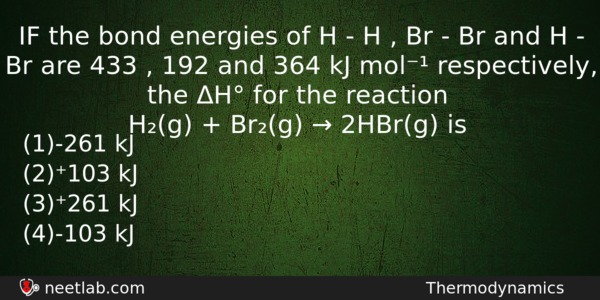| ⇦ | 
| ⇨ |
IF the bond energies of H – H , Br – Br and H – Br are 433 , 192 and 364 kJ mol⁻¹ respectively, the ΔH° for the reaction
H₂(g) + Br₂(g) → 2HBr(g) is
Options
(a) -261 kJ
(b) ⁺103 kJ
(c) ⁺261 kJ
(d) -103 kJ
Correct Answer:
-103 kJ
Explanation:
H – H + Br – Br → 2H – Br,
(433) + (192) (2 x 364)
=625 =728
(Energyabsorbed) (Energy released)
Net energy released = 728 – 625 = 103 KJ. i.e. ΔH = -103 KJ.
Related Questions: - Rectified spirit has ethanol
- 300 mL of a gas at 27⁰C is cooled to -3⁰C at constant pressure
- The molecular of CO₂ has angle 180°.It can be explained on the basis of
- A mixture of two salts is not soluble in water but dissolves completely in dilu
- An example of amino acid containing benzene ring is
Topics: Thermodynamics
(179)
Subject: Chemistry
(2512)
Important MCQs Based on Medical Entrance Examinations To Improve Your NEET Score
- Rectified spirit has ethanol
- 300 mL of a gas at 27⁰C is cooled to -3⁰C at constant pressure
- The molecular of CO₂ has angle 180°.It can be explained on the basis of
- A mixture of two salts is not soluble in water but dissolves completely in dilu
- An example of amino acid containing benzene ring is
Topics: Thermodynamics (179)
Subject: Chemistry (2512)
Important MCQs Based on Medical Entrance Examinations To Improve Your NEET Score
18000+ students are using NEETLab to improve their score. What about you?
Solve Previous Year MCQs, Mock Tests, Topicwise Practice Tests, Identify Weak Topics, Formula Flash cards and much more is available in NEETLab Android App to improve your NEET score.
Share this page with your friends

Leave a Reply